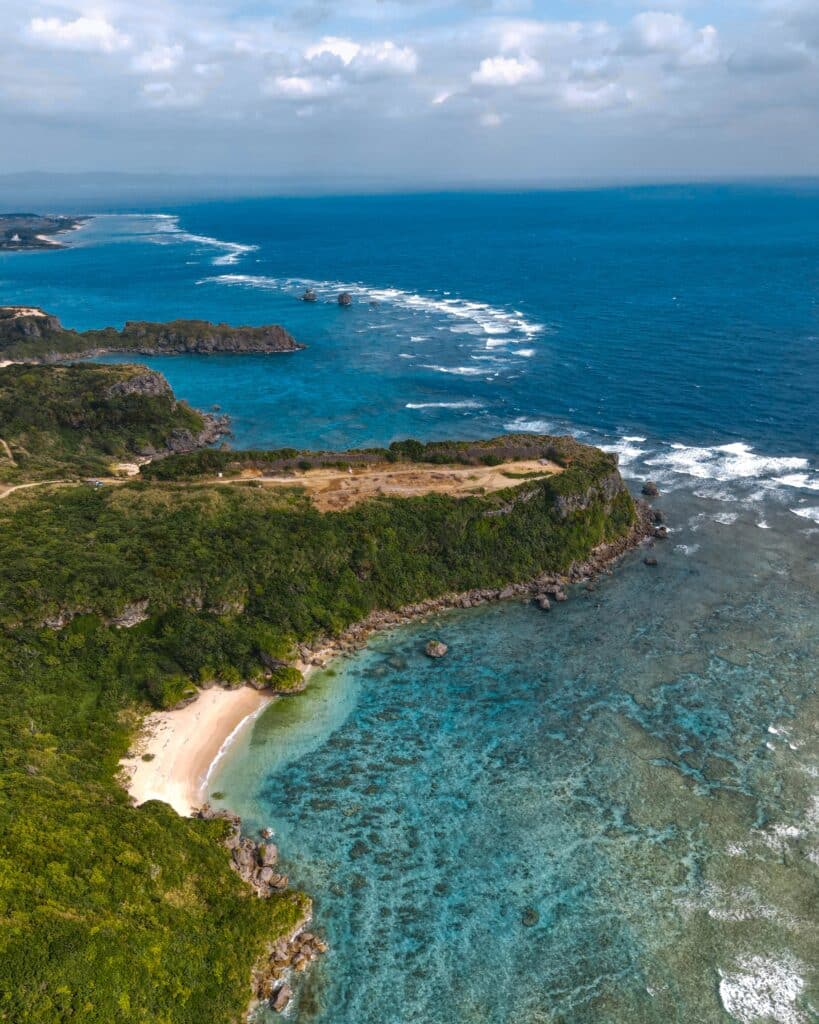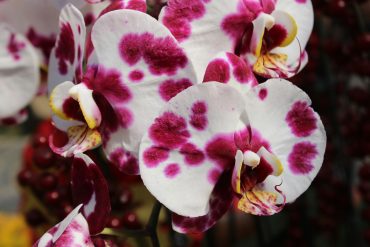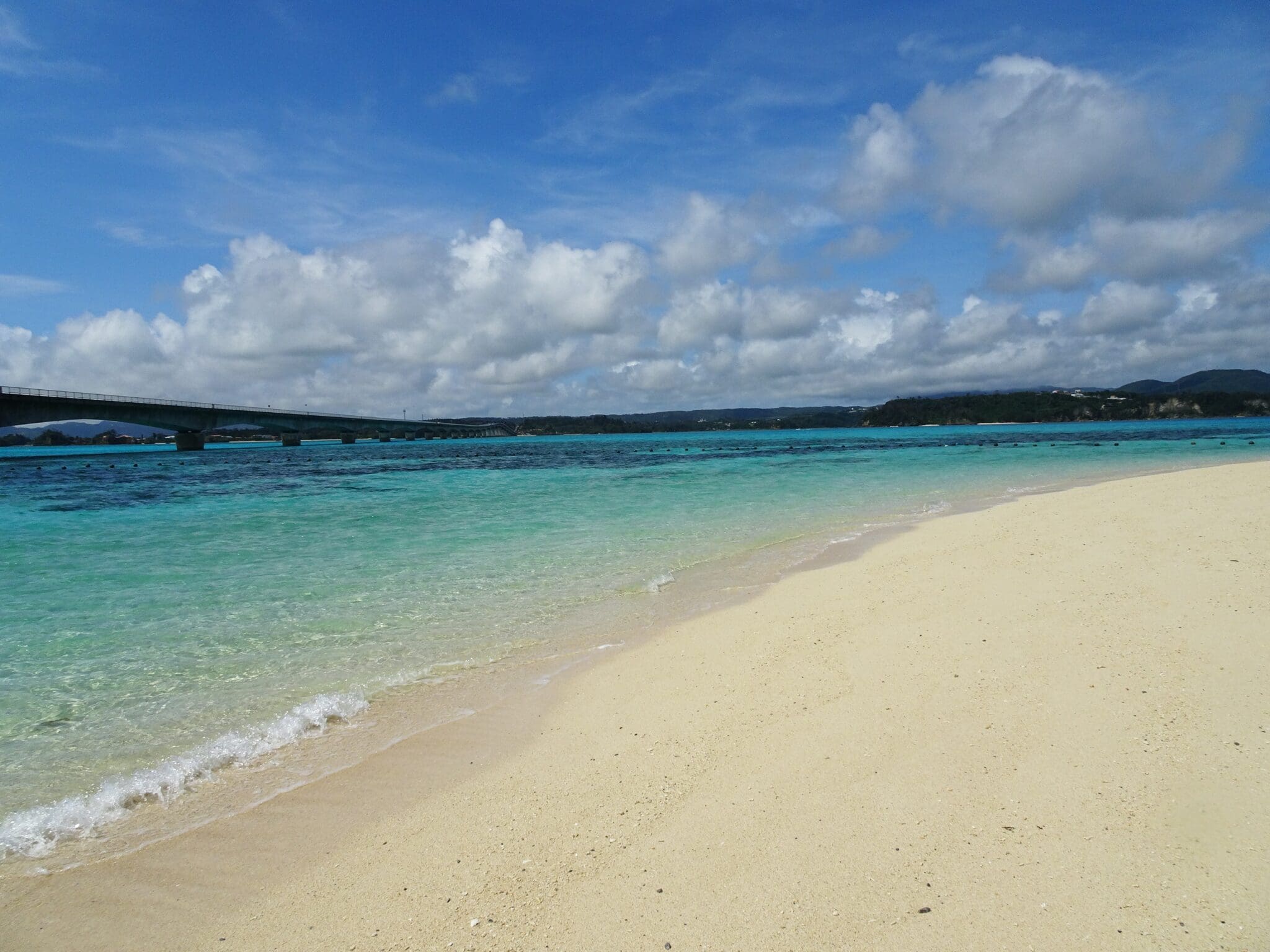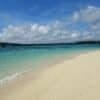Life in Okinawa Under the American Military
Author’s Memo
I was delighted and honored to have won a year-long fellowship in Japan. Everyone was happy for me, from colleagues to friends and family, and my wife and kids looked forward to a year-long adventure. I was eager to get back to the land of the rising sun, where I’d enjoy hiking in the mountains, soaking in the onsens, and leisurely eating my way through the entirety of Japanese cuisine. It had been seventeen years since I last lived there, and a year since my last visit. And then, unexpectedly, I learned that the granting agency had assigned me to the University of the Ryukyus in Okinawa. “Okinawa?” I thought. “I don’t know shit about Okinawa.”
So, before I left, I set out to learn as much as possible. Every day I studied a map of its geography. I researched the island culture and its climate. I read about the history of the Kingdom of the Ryukyus, and plowed through a depressing tome on the Battle of Okinawa. Okinawa lit a fire under me, and in hindsight, no placement could have been better, but it was a tough year. I thought I knew Japan and knew what I was getting into, but Okinawa is a very different place. As one Japanese friend put it, “Okinawa is Japan, but it is not Japan.”
“Okinawa is Japan, but it is not Japan.”
Since 1879, when Okinawa became a Japanese prefecture, Tokyo has neglected it in many ways. This is most evident today in the disproportionate number of U.S. armed forces on Okinawa. It is a controversy Japan and the U.S. can’t continue to ignore. The island is 0.6% of the Japanese land mass, and home to 75% of U.S. military facilities in Japan. Okinawans recognize threats in the region, but they do not like that Tokyo requires them to shoulder most of the burden. Their wishes, however, are ignored. Part of the problem is that the island and its people are culturally different. It is technically Japan, of course, but for most of its history it was a sovereign nation.
This piece describes my research and observations into the impact the U.S. military has had on the island, and tells the story of the Japanese government’s historical culpability by colonizing, controlling, and discriminating against the island. Polls show Okinawan opinion to be largely negative about the American military. However, there are those who recognize China as a growing threat to Taiwan and to the region, and they appreciate the protection, the stability, and the economic benefit the bases arguably bring. But after 70 years of playing host to the American military, Okinawa is still the poorest prefecture in Japan. It makes you wonder whether the benefits outweigh the risks.
‘This piece describes my research and observations into the impact the U.S. military has had on the island, and tells the story of the Japanese government’s historical culpability by colonizing, controlling, and discriminating against the island.
The story starts with the routine disruptions that people on Okinawa must live with, everyday intrusions caused by military flyovers and that I experienced while living there. It discusses the undercurrent of fear Okinawans are forced to live with because of the most notorious calamities and accidents caused by the American military, not to mention the crimes and misdemeanors of military personnel. The essay then turns to a description of the excesses plainly evident while visiting an American military base, and explains Okinawan resistance and history as basis for understanding the conclusion, which argues that Tokyo’s low regard for and discrimination of Okinawans is at least one reason why the great majority of U.S. forces in Japan are located on Okinawa.
I was an American Fulbright scholar and civilian living on Okinawa and teaching at the University of the Ryukyus in 2014-2015, and I have spent many years in Japan. This story started as an op-ed in the Japan Times at:

Life in Okinawa Under the American Military
The flyovers come day and night. In the morning my ninth-floor apartment shakes under the rocket roar of an F-15 or the throaty thumps of an HH-60 helicopter. They last only a few seconds, but often there is more than one group separated by a few minutes each. Most afternoons promise the humming turboprops of a V-22 Osprey, the aircraft that takes-off and lands vertically like a helicopter, rotates its engines and flies like a plane. The Osprey’s distant drone morphs into a burly thwack until it hits you in the chest with a descending rumble as it passes overhead. It raises my heart rate. I fight the impulse to take cover under my desk. I can’t help but wonder if this particular flyover is going to be the next fatal blunder.
Comedy is tragedy plus time, but time has not softened what the Okinawans have endured. Admittedly, Monty Python’s sixteen-ton weight came to mind when I read of the eleven-year-old Okinawan girl crushed by a trailer inadvertently jettisoned by a military aircraft in 1965. Not funny, I know, and that’s just one horror in a laundry list of calamities involving U.S. military aircraft on the island of Okinawa.
“Comedy is tragedy plus time, but time has not softened what the Okinawans have endured.
The most notorious occurred in 1959 when an F-100 Super Sabre caught fire, the pilot ejected, and the plane crashed into Miyamori Elementary School, killing 18 students. A 2013 film, Himawari captured the disaster. Okinawans were reminded of this tragedy in 2004 when a U.S. Marine Corps Sea Stallion helicopter crashed on the campus of Okinawa International University. Another mishap occurred in August 2013 when an HH-60 helicopter crashed two kilometers from a residential area during a training exercise before deployment to Afghanistan. The helicopter was a total loss, costing American taxpayers $38 million dollars. And while I’m on the subject of money, only three months earlier a $32 million F-15 malfunctioned, forcing the pilot to eject before sending the plane into the Pacific Ocean.
‘Many Okinawans recognize the regional threats, but they dislike that Tokyo requires them to shoulder most of the burden.
For years Okinawans have protested military flyovers, but their objections have been in vain. The best example is the V-22 Osprey. The aircraft has a controversial safety record, yet it arrived on Okinawa in 2012 against the wishes of all 41 Okinawan municipalities, and although there haven’t yet been any Okinawans killed or injured by the Osprey, residents are justifiably concerned. Most recently, on June 8, 2022, five Marines died on a training mission when their Osprey went down in California. In August 2017 an Osprey struck a ship and killed three marines in Australia.
In December 2016, an Osprey went down off the coast of Okinawa one week after an F/A-18 Hornet crashed off the coast killing the pilot, just two of eight crashes in 2016. While I was in Okinawa there were three such crashes in 2014 and six in 2015 involving Marine Corps aircraft. Understandably, Okinawans want to prevent the next catastrophe, not to mention that they’re tired of the noise and the pollution. And while most of the flyovers are American, occasionally it’s a Japanese F-15 shrieking overhead to ward off a Chinese aircraft skirting along Japanese airspace.
‘At the heart of the controversy is the U.S. Marine Air Station Futenma where training flights create noise, pollution, and endanger residents in heavily populated Ginowan City.
China has been flexing its military muscle for some time now. It’s been patrolling the Senkaku islands – which Japan controls but China claims – and the Chinese defense budget has seen double-digit increases for almost every year over the last twenty. The Chinese coast guard has grown 25 percent and, along with its maritime coastal fleet, is bigger than the resources of Japan, Vietnam, Indonesia, Malaysia and the Philippines combined. In recent years, China has launched more ships than any other country, and today boasts more warships than the U.S. Navy, not to mention that it is growing its fleet of submarines and continues to update its missiles and weaponry.
Along with this military expansion, China dredged to expand two disputed islands in the Paracel Archipelago east of Vietnam and has also pumped sand onto shallow reefs to create new islands among the Spratly Islands in the South China Sea. Whether or not China poses a threat is an issue of argument. The American media and the U.S. Congress often agree that China is a growing adversary. Academics, however, debate China’s actions. Sociologist Amitai Etzioni describes the two camps as consisting of the “adversarians” who see China’s economic growth, military expansion, and “ideational” success as adversarial. [1] The second camp are the “engagers” who argue that China is developing peacefully and should be engaged peacefully, that their military expansion is not adversarial but only part and parcel of their economic growth.[2]
‘It reminded me of Pablo Picasso’s sculpture, “Death’s Head.” It’s disturbing and silence pervades among visitors.
Many Okinawans recognize the regional threats, but they dislike that Tokyo requires them to shoulder most of the burden. The island hosts a disproportionate number of American Forces in Japan. Okinawa is home to 75 percent of the U.S. military in Japan, but represents only 0.6 percent of the Japanese land mass. Some economic perks come with this, like the 8,000 Japanese employed on bases and the 10 billion yen ($88 million) Tokyo pays the prefectural government for accommodating the American military. Since the end of WWII, one argument in favor of the American military presence in Okinawa has centered on the economic advantages. Yet, after 75 years of playing host, Okinawa is still the poorest prefecture in Japan. It makes you wonder whether the benefits outweigh the risks.
At the heart of the controversy is the U.S. Marine Air Station Futenma where training flights create noise, pollution, and endanger residents in heavily populated Ginowan City. The plan for over a decade has been to move the base north to less populated Henoko, but Okinawans voted against this plan in 2014 when they ousted the gubernatorial incumbent and elected Takeshi Onaga on his strong, anti-base position. Onaga promised to reverse approvals to move the base, and current governor Denny Tamaki has continued this resistance as the protest movement has grown into the majority on the island.
‘The first thing that strikes you is the generous amount of space.
My wish to see Futenma Marine Air Station brought me immediately south of it, to Kakazutaka Memorial Park where some of the bloodiest fighting took place during the Battle of Okinawa. The military refers to it as Kakazu Ridge, and it’s where the famous Japanese General Ushijima fought grimly, even attempting to go on the offensive. Ultimately the Japanese could not compete with American firepower and near the end of the battle Ushijima committed seppuku, or ritual suicide. Conditions there, for both armies, mimicked WWI as the May typhoon season brought heavy rains that washed-out roads and made it difficult to evacuate the dead and the wounded. Mud, humidity, heat, decaying bodies, and maggots made it hell on earth for soldiers and civilians who lived and died there.
Inside the park is a single wall preserved from a period house marred by bullet holes. The wall is at the base of a long staircase at the top of which you reach an observatory with a panoramic view of the cities of Ginowan and Urasoe, and directly in front of you is Futenma Marine Air Station. From this perspective you can see both the large scale of the base, the sheer acreage necessary to create such a military air compound, and also the peril of continuing to use a base in an area that has become densely populated. In some areas civilian homes abut the base’s chain-link fencing, topped with concertina wire. The airstrip faces you, and during my visit a half dozen Ospreys were noisily taking-off or landing.
‘On the other side was the dining room, a kitchen bar-counter, and a balcony with the stereotypically oversized stainless steel American propane grill.
In another area of the park is a Japanese “pillbox” or bunker. From the backside it looks to be a perfect and impervious concrete cube with an entrance for soldiers to crawl through and solid walls several inches thick. Inside it is noticeably cooler by several degrees, the thick walls built to withstand an onslaught of enemy fire unintentionally providing relief from the jungle heat. But walk around to the front, the side with the “loopholes” or horizontal slits for firearms, and your impression changes, it becomes more ominous. A third of the box is blown away, with crisscrossing scars, twisted and rusting rebar sticking up, and it has a density, it has a heaviness in both literal and metaphoric ways, the coarse and uneven texture like a piece of dark, sinister modern art. It reminded me of Pablo Picasso’s sculpture, “Death’s Head.” It’s disturbing and silence pervades among visitors.
The view of Futenma Air Base piqued my interest. I needed to see a base from the inside, and I had the opportunity to visit both Camp Foster and Camp Kinser, two bases named after Marines who in separate incidents died when they threw themselves on live hand grenades. Entering a U.S. military base is like entering a surrogate United States. Most military personnel may not feel that way, but Americans build and maintain these bases, so they have undeniably American characteristics.
‘At that point, though, he didn’t feel as if he could say who or what an Okinawan was.
The first thing that strikes you is the generous amount of space. There is limited space in Japan and living there requires efficient and resourceful use of it. Total Japanese land mass is less than California (145,932 sq. mi. vs. 163,696 sq. mi.), but the Japanese population is about 40 percent of the U.S. population. Put simply, if you shoved about half of the U.S. population into California, you’d have the approximate population density of Japan. Japan is tight but comfortable, but on Camp Foster and Camp Kinser you are starkly aware of the open, uninterrupted, luxurious space, and the wide Kansas City boulevards. There’s plenty of elbow room.
I was in Okinawa as an employee of the State Department, but that did not get me on base. With no military affiliation, you must have a “sponsor” to enter a base. One of my sponsors was a military chaplain who lived with his family of four in an apartment tower, one of many built of reinforced concrete to withstand typhoons. In between were large swaths of green lawn. The chaplain’s apartment was a spacious middle-class dwelling, with three bedrooms, a kitchen ample by Japanese standards, with a big American range and full-size refrigerator, a washer and dryer and garbage disposal.
In contrast, my Japanese apartment had a tiny fish grill, two gas burners, and a frig not much bigger than those in a college dormitory room. Their living area accommodated a 42-inch television, a large sofa, a love seat, a La-Z-Boy chair, as well as two desks with office chairs. On the other side was the dining room, a kitchen bar-counter, and a balcony with the stereotypically oversized stainless steel American propane grill.
‘Okinawa was beyond the chain-linked fence where traffic was gridlocked, and the typhoon-weary buildings had business signs scrawled in hiragana, katakana, and kanji.
With the exception of the appliances, the family owned the furnishings. In order to do a three-year stint, the chaplain and his family sold their home in the states, and the military shipped all of their belongings, a total of 6000 lbs. to Okinawa. A lot of weight, but still 2000 lbs. short of the 8000 lbs. maximum. Even so, the chaplain admitted to shipping everything he owned, even things he didn’t need, like an aluminum extension ladder. “It made no sense,” he said, “to pay to store the stuff in the U.S. if they’d ship it and store it for nothing.”
Minutes after entering his apartment, his wife handed me a bottle of Sierra Nevada Pale Ale and offered me and my family snacks including a bowl of Cheez-Its and another of Chex Mix. His wife smiled and bent at the waist to ask my children what American food they missed most. In unison my children yelped, “Cheerios!” then waited impatiently for the adults to finish their drinks, so we could make our way to the commissary. We jumped in our cars and I followed the chaplain down the wide streets. We passed a Popeye’s Chicken and a Subway and the bowling alley and the casino, and the movie theater, which he explained wasn’t doing well financially since most military personnel stream movies these days.
‘Ultimately, though, he was an unapologetic “adversarian” in that he understood the threats in the region to be real and believed strongly in the necessity of American military presence in Asia, and in Okinawa specifically.
Our first stop was the PX. As I stepped out of the car, I could have been in the parking lot of a Cracker Barrel after exiting Interstate 70 in Indiana. Country-western music wafted from outdoor speakers, and car and motorcycle dealerships were running a joint promotion. A new Ford Mustang and a Jeep Commander sat burnished and awaiting test drivers. A salesman standing next to a gleaming Harley Davidson asked me, “Wanna take ‘er for a spin?” The only reminder that this was Okinawa was beyond the chain-linked fence where traffic was gridlocked, and the typhoon-weary buildings had business signs scrawled in hiragana, katakana, and kanji.
The PX is an American department store in an American shopping complex, what any American experiences at any strip mall, in any state in the union. The difference is that this strip mall sits 7000 miles from the mainland. Likewise, the commissary is an American supermarket, but they stopped me at the door. The chaplain warned me of this, saying enforcement varied. Technically no one but military personnel are allowed to shop for food at the commissary because no sales taxes are charged. Allowing public access would put local businesses at a disadvantage, not to mention that letting local civilians in would make it more difficult to keep the store stocked. People want what they can’t get. So, I sat down outside and my sponsor took my cash and my kids (for some reason, my children were allowed to enter) to buy their coveted breakfast cereal.
Aerial maneuvers pose a constant threat to Okinawans, but so do the crimes of servicemen on the ground.
Military bases are American cities slapped down thousands of miles from the United States at enormous labor and cost. And Futenma, Foster, and Kinser are only three of nine Marine Corps bases on Okinawa. If I felt uneasy about it, the chaplain understood better than anyone. His life in Okinawa was not what he expected. In many ways it was as if he and his family weren’t even living abroad. He shopped on base and much of their recreation took place at base facilities and through base programs and activities and saw American faces, interacted with Americans and heard English exclusively.
He lived in a vacuum and this was true even on the days when he traveled to other parts of the island to see G.I.s on other bases and drove on a superhighway and an electronic commuter tag on the dashboard allowed him to pass through the tollgate. On his commute he streamed NPR Portland, which meant he listened to the same broadcast that his relatives listened to in the states. To his credit he and his wife sent their children to school off-base, which is how we met. At that point, though, he didn’t feel as if he could say who or what an Okinawan was.
‘Violent crimes like these reverberate and ignite the protest movement on the island.
Over the course of our acquaintance, he and I had the inevitable discussions about the American military, and he revealed himself to be sympathetic to the local community. Ultimately, though, he was an unapologetic “adversarian” in that he understood the threats in the region to be real and believed strongly in the necessity of American military presence in Asia, and in Okinawa specifically. This remained true for him regardless of the growing Okinawan anti-base movement, or the military aircraft accidents, or the many media reports on crimes committed by servicemen, which also greatly contributes to Okinawan resistance.
Aerial maneuvers pose a constant threat to Okinawans, but so do the crimes of servicemen on the ground. Some of the more high-profile crimes include the Yumiko-chan incident in 1955 when an American soldier raped and murdered a six-year-old girl and left her body in a garbage dump on Kadena Air Base; the 1995 abduction and rape of a 12-year-old by three servicemen; the 2016 rape and murder of 20-year-old Rina Shimabukuro by a former Marine who had become a civilian employee on Kadena Air Base; and the most recent murder of a 44-year-old Japanese woman by a former Navy sailor in April, 2019. Violent crimes like these reverberate and ignite the protest movement on the island.
The military has had success reducing the overall number of violent crimes committed by American personnel. However, the everyday misdemeanors – from traffic accidents to disorderly conduct – accumulate to strengthen Okinawan opposition to the American military presence. A Japanese lawyer wondered aloud to me why young, intoxicated servicemen feel entitled to enter the homes of residents late at night to sleep on the couch. “It happens frequently,” he said, “Sometimes they even plug-in their cell phones.”
‘…not surprising, then, when polls show Okinawan opinion to be largely negative toward the American military.
It is not surprising, then, when polls show Okinawan opinion to be largely negative toward the American military. Few Okinawans claim to appreciate the protection, the regional stability, and the economic benefits the bases arguably bring. Most of my Okinawan colleagues are angered by the seizure of large swaths of prime real estate on an island slightly smaller than Oahu, and they are fed-up with the frequent flyovers, the accidents, and the crimes of servicemen. Still others say, in typical Japanese fashion, “Shikata ga nai,” or “It cannot be helped.” They are resigned to it and understand that Japanese militarism led to one of the bloodiest battles of WWII and the subsequent American occupation of the island. The only surprise to me is that for many anti-base Okinawans, the U.S. isn’t the locus of the problem; it’s Tokyo, where the Japanese government is set on maintaining the status quo.
The Ryukyu Islands have a long history of being controlled and directed by policy from mainland Japan. Okinawans have had little sway in Tokyo. One reason is that the island and its people are different. For most of its history, Okinawa was a sovereign nation, and the people are an ethnic minority in Japan. Okinawans are proud of their history as the Ryukyu Kingdom. They understand their identities in contrast to the Japanese. The culture is unique, vibrant, and frequently celebrated on the island, and it shows strong influences from China and Southeast Asia. Add the huge American footprint, and you wonder whether you’re in Japan at all. These differences cause some mainland Japanese to discriminate against Okinawans, and this bias has a long history.
‘The Ryukyu Islands have a long history of being controlled and directed by policy from mainland Japan.
All Okinawans mark the end of their sovereignty in the year 1609 when the Satsuma Japanese invaded Okinawa. The Satsuma came from Kyushu, the closest Japanese island, on 100 ships carrying 3000 warriors and took control. For 200 years before the invasion, Okinawa experienced a golden age. The island unified in 1429, and they’d built an economy based on international trade. They were respected mariners who acted as couriers – a kind of UPS of the East – trading goods with countries all over Asia and as far west as Portugal. China even entered into an agreement with the Okinawans, providing them ships in return for delivering Chinese goods to foreign ports. But after the invasion, it all ended.
Why the Satsuma invaded is still argued today. Officially, the Japanese government granted permission for the invasion of 1609 because the Okinawans failed to show due respect to the Japanese shogun. Japan had just emerged from the Sengoku period, a long period of turmoil and war, which culminated in the famous Battle of Sekigahara and the rise of Tokugawa to shogun. The Satsuma clan had fought on the losing side, but Tokugawa was merciful, requiring only that the Satsuma ruler abdicate.
The new Satsuma leader traveled to see Tokugawa to show respect and thank him for his leniency. The Satsuma also sent an envoy to Okinawa to demand that the Okinawan king do the same, but rather than travel the arduous 1000 miles across the sea, the Okinawan king politely sent his regrets. The king may not have realized the significance of the battle of Sekigahara, and people may have advised him not to meet the demand by a court who, like any political body, was partisan at the time. One faction was pro-Japan, while the other was pro-China.
‘Officially, the Japanese government granted permission for the invasion of 1609 because the Okinawans failed to show due respect to the Japanese shogun.
Some historians believe the Satsuma took advantage of this Okinawan snub as an excuse to invade because they had a different motive.[3] The Japanese government had instituted a seclusion policy, effectively sealing-off Japan from the rest of the world. The only port allowing international trade was Nagasaki on Kyushu. The Satsuma watched as Tokugawa enriched himself through their port. They wanted a piece of the action, so they seized the opportunity to invade and control the port in Naha, Okinawa in order to dodge the national seclusion policy. After the invasion of 1609, the Satsuma shuttled the Okinawan king and his councilors to a shrine on Kyushu where under duress the Okinawans signed an agreement to give Satsuma control of trade through the port of Naha.
When one of the king’s pro-China advisors refused to sign the agreement, they seized and summarily beheaded him, evaporating any remaining resistance in the king’s court. The agreement enabled the Satsuma to trade surreptitiously with China through the Naha port, enriching themselves and slowly draining the Okinawans. The golden age of Okinawan maritime trade was over. For the next two centuries Okinawa maintained domestic freedoms, but their leadership was a puppet monarchy exploited by the Satsuma.
‘Called the “Typhoon of Steel,” the Battle of Okinawa started with the largest amphibious assault in history, and lasted 82 days during which 77,000 Japanese perished, along with 12,000 Americans, and another 2,000 Allied troops.
In the 19th century the Japanese government moved to annex northern and southern islands to create a definitive Japanese border. The Japanese and Russians made competing claims for islands to the north, which led to the official annexation of Hokkaido in 1868. Fear of European claims in the south led to Okinawan annexation in 1879 with no Okinawan input. Tokyo unilaterally abolished the Ryukyu Kingdom and annexed it to provide a distant southern barrier for mainland Japan. Beyond its use as a border, mainland Japanese viewed Okinawa as a liability, and Okinawan people were held in low regard and discriminated against at home and on the mainland. It wasn’t until 1920 that the island became a prefecture with voting rights equal to others.
By 1945, the lack of concern for Okinawans became most evident when Japanese leaders knew they had little chance to win the war, yet they chose to sacrifice Okinawa in the bloodiest battle of the Pacific. Called the “Typhoon of Steel,” the Battle of Okinawa started with the largest amphibious assault in history, and lasted 82 days during which 77,000 Japanese perished, along with 12,000 Americans, and another 2,000 Allied troops. Some estimates are as high as 150,000 Okinawan civilians killed in the crossfire.
‘If the U.S.-Japan alliance is today, as Shinzo Abe claimed, “an alliance of hope,” it must include the hopes of Okinawans.
Former Prime Minister Shinzo Abe reaffirmed the U.S.-Japan military alliance in a speech to U.S. Congress in 2015. He thanked the U.S. armed forces for “rushing to Japan to the rescue” during the 2011 tsunami. However, Abe and his successors, Yoshihide Suga and Fumio Kushida, continue to neglect the disproportionate number of U.S. armed forces on Okinawa. It’s a controversy that Tokyo and the U.S. continue to ignore. Since the 17th century, Okinawans have dealt with invasion, exploitation, annexation, war, occupation, and discrimination. And since the end of World War II, Tokyo has forced Okinawans to deal with the dangers and the questionable dividends of living in proximity to the American military.
The disproportionate presence of American Forces on Okinawa is at least in part the continuation of Tokyo’s low regard for the island and its people. If the U.S.-Japan alliance is today, as Shinzo Abe claimed, “an alliance of hope,” it must include the hopes of Okinawans.
[1] “Ideational success” in this context is the belief that Chinese authoritarian capitalism is a better model than democratic capitalism.
[2] Amitai Etzioni, “China: Making an adversary.” International Politics, vol. 48, no. 6, (2011): 647-666.
[3] George H. Kerr, Okinawa: The History of an Island People (Tokyo: Tuttle Publishing, 2000).
Credits
Image of Okinawa Island for Pexels by Spacy Goody
Featured Image by Finn for Unsplash
Learn More
New to autoethnography? Visit What Is Autoethnography? How Can I Learn More? to learn about autoethnographic writing and expressive arts. Interested in contributing? Then, view our editorial board’s What Do Editors Look for When Reviewing Evocative Autoethnographic Work?. Accordingly, check out our Submissions page. View Our Team in order to learn about our editorial board. Please see our Work with Us page to learn about volunteering at The AutoEthnographer. Visit Scholarships to learn about our annual student scholarship competition.
Primo Ventello was a Fulbright scholar in Japan. Three of his essays have been recognized as “Notable” in Robert Atwan’s Best American Essays. He lives and teaches in Kansas.











